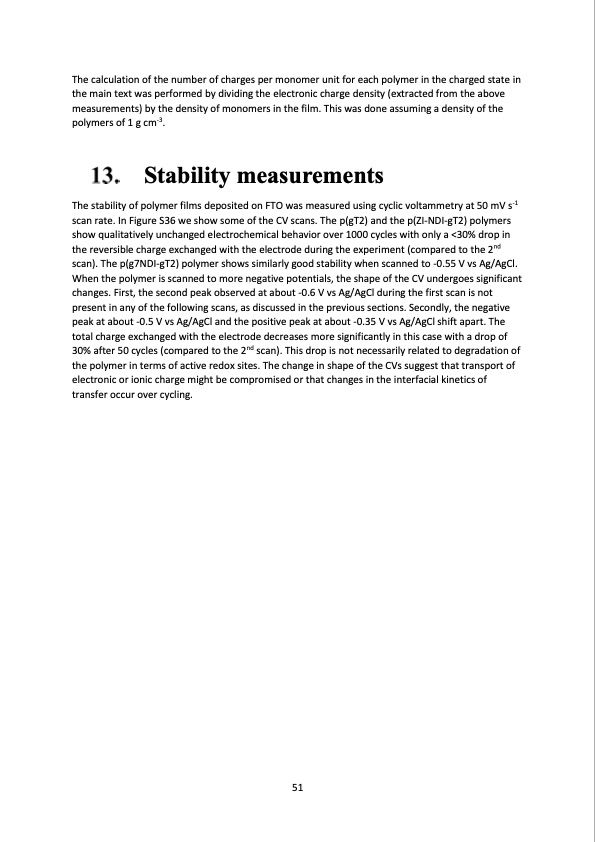
PDF Publication Title:
Text from PDF Page: 051
The calculation of the number of charges per monomer unit for each polymer in the charged state in the main text was performed by dividing the electronic charge density (extracted from the above measurements) by the density of monomers in the film. This was done assuming a density of the polymers of 1 g cm-3. Stability measurements The stability of polymer films deposited on FTO was measured using cyclic voltammetry at 50 mV s-1 scan rate. In Figure S36 we show some of the CV scans. The p(gT2) and the p(ZI-NDI-gT2) polymers show qualitatively unchanged electrochemical behavior over 1000 cycles with only a <30% drop in the reversible charge exchanged with the electrode during the experiment (compared to the 2nd scan). The p(g7NDI-gT2) polymer shows similarly good stability when scanned to -0.55 V vs Ag/AgCl. When the polymer is scanned to more negative potentials, the shape of the CV undergoes significant changes. First, the second peak observed at about -0.6 V vs Ag/AgCl during the first scan is not present in any of the following scans, as discussed in the previous sections. Secondly, the negative peak at about -0.5 V vs Ag/AgCl and the positive peak at about -0.35 V vs Ag/AgCl shift apart. The total charge exchanged with the electrode decreases more significantly in this case with a drop of 30% after 50 cycles (compared to the 2nd scan). This drop is not necessarily related to degradation of the polymer in terms of active redox sites. The change in shape of the CVs suggest that transport of electronic or ionic charge might be compromised or that changes in the interfacial kinetics of transfer occur over cycling. 51PDF Image | salt water battery with high stability

PDF Search Title:
salt water battery with high stabilityOriginal File Name Searched:
salt-water-battery.pdfDIY PDF Search: Google It | Yahoo | Bing
Product and Development Focus for Salgenx
Redox Flow Battery Technology: With the advent of the new USA tax credits for producing and selling batteries ($35/kW) we are focussing on a simple flow battery using shipping containers as the modular electrolyte storage units with tax credits up to $140,000 per system. Our main focus is on the salt battery. This battery can be used for both thermal and electrical storage applications. We call it the Cogeneration Battery or Cogen Battery. One project is converting salt (brine) based water conditioners to simultaneously produce power. In addition, there are many opportunities to extract Lithium from brine (salt lakes, groundwater, and producer water).Salt water or brine are huge sources for lithium. Most of the worlds lithium is acquired from a brine source. It's even in seawater in a low concentration. Brine is also a byproduct of huge powerplants, which can now use that as an electrolyte and a huge flow battery (which allows storage at the source).We welcome any business and equipment inquiries, as well as licensing our flow battery manufacturing.| CONTACT TEL: 608-238-6001 Email: greg@salgenx.com | RSS | AMP |